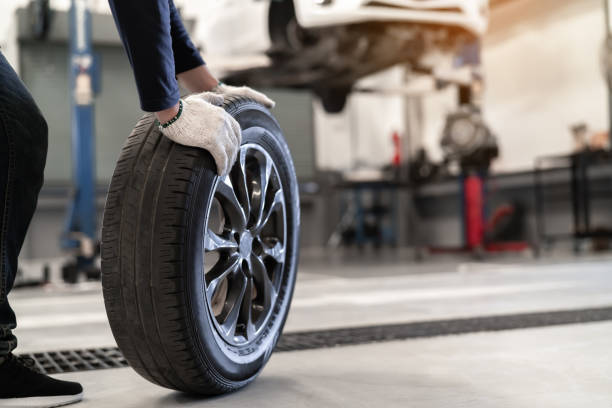How Often to Rotate Tires: All You Need To Know

Tire maintenance is crucial for your vehicle’s safety, performance, and long life. Regular rotation is the most indispensable aspect of tire care. How often do you rotate, change, or replace tires? Today, we will answer all the questions that come to your mind.
We shall discuss all there is to know about tire rotation, such as the frequency and best timing for changing or replacing the tires, including, in perfect practice, keeping your tires in proper condition.
Understanding Tire Rotation
Tire rotation is moving tires from one position on a vehicle to another. The purpose is to ensure even wear across all four tires, extending their lifespan and improving overall vehicle performance.
Why Rotate Tires?
- Even wear: Different positions on a vehicle experience different amounts of stress, leading to uneven wear if tires aren’t rotated.
- Extended tire life: By distributing wear evenly, you can maximize the lifespan of your tires.
- Improved performance: Evenly worn tires provide better traction and handling.
- Enhanced safety: Properly rotated tires are less likely to fail unexpectedly.
- Maintain warranty: Many tire warranties require regular rotation to remain valid.
How Often to Rotate Tires
Here are some general guidelines. The type of vehicle, driving habits, and the manufacturer’s recommendations all play roles, but generally speaking, most automotive experts and tire manufacturers recommend a tire rotation every 5,000 to 8,000 miles or six months, whichever comes first.
Factors Influencing Rotation Frequency
Type of car: Some cars have front-wheel drive, some rear-wheel drive, all-wheel drive, and four-wheel drive, thus requiring different types of rotation.
Tires: One such consideration is driving conditions. If you travel on bad roads or experience terrible weather, you may need to rotate your tires more frequently.
The Type of Tire: High-performance or off-road tires may require more frequent rotation.
Driving: Aggressive driving and carrying hefty loads can increase the frequency of rotation.
Signs You May Need to Rotate Your Tires Sooner
- Uneven tread wear
- Vibration while driving
- Noise from the tires
- Decreased fuel efficiency
How Often to Change Tires

While rotation helps extend tire life, eventually, you’ll need to change your tires. The frequency of tire changes depends on several factors:
Tread Depth
The most significant indicator of when a tire must be replaced is its tread depth. Most tires contain built-in wear bars at the tread-to-roadway interface; a good indicator that it is time to replace the tire is when the wear bar is level with the tread surface.
Alternatively, you may prefer the “penny test,” in which you insert a penny into the tread so that Lincoln’s head is upside down. If you can see the top of his head, your tires should be replaced.
Age
Though tread depth is sufficient, tires degrade over time due to heat, sunlight, and air exposure. Many manufacturers recommend replacing tires that are 6-10 years old, regardless of tread depth.
Damage
Cuts, bulges, or other visible damage can necessitate tire replacement, regardless of age or tread depth.
How Often Should I Change My Tires?
The average lifespan of a tire is 25,000 to 50,000 miles. However, high-quality ones will reach 80,000 if used and cared for accordingly.
It also depends on a lot of variables from below:
Driving Habits: Aggressive drivers consume more tires.
Road Conditions: Poor roads get worn-out tires sooner.
Climate: Extreme temperature changes affect tire lifetime.
Maintenance: Proper inflation and obligatory rotation support the service life of tires to a greater extent.
Quality of Tires: The more quality it possesses, the more durable it is.
How Often Should Tires Be Rotated?
Tires must be rotated every 5,000 to 8,000 miles or every six months. However, the owner’s manual for your vehicle and the tire manufacturer should also confirm this.
Rotation Patterns
The pattern for rotating your tires depends on your vehicle type and whether you have directional or non-directional tires:
- Front-wheel drive vehicles: Move the front tires straight back and the rear tires diagonally to the front.
- Rear-wheel drive vehicles: Move the rear tires straight forward and the front tires diagonally to the rear.
- All-wheel drive vehicles: Cross both sets of tires diagonally.
- Directional tires: These can only be rotated front to back on the same side of the car.
See More: 7 Awesome Tips To Prepare Your Off-Road Vehicle
Best Practices for Tire Maintenance
In addition to regular rotation, here are some best practices to keep your tires in top condition:
Check tire pressure monthly: Good inflation will add to even tire wear and ideal performance.
Balance tires: Rotate your tires and have them balanced so that they wear evenly.
Align the wheels: Proper alignments prevent uneven wearing and improve vehicle handling.
Regular Inspection: check for signs of damage, uneven wear, or foreign objects in the tread.
Replace spare tire: If you have a full-size spare, add it to the rotation cycle.
The Impact of Neglecting Tire Rotation
Failing to rotate your tires regularly can lead to several issues:
Premature tire wear: Some parts of your car experience more stress than the other, and if tires are not rotated, they will wear out faster on those parts.
Poor performance: Unequal tires may lead to reduced steering or braking effectiveness.
Increased fuel consumption: The scrubbing action of a tire with uneven wear increases rolling resistance so that its fuel efficiency suffers.
Safety risks: Worn-out tires raise the chances of a blowout and loss of grip.
Higher costs: Failure to rotate tires results in a higher number of replacements, thus increasing the care cost on your vehicle.
When to Seek Professional Help
While some car enthusiasts might feel comfortable rotating their tires, it’s often best for professionals to perform this service. Here’s when to consider professional help:
- Lack of proper tools: Tire rotation requires specialized equipment like a car lift and torque wrench.
- Uncertainty about rotation pattern: Different vehicles require different rotation patterns.
- Additional services needed: Professionals can perform other maintenance tasks like balancing and alignment during rotation.
- Warranty considerations: Some warranties require professional rotation to remain valid.
The Environmental Impact of Proper Tire Maintenance
Proper tire maintenance, including regular rotation, doesn’t just benefit your vehicle and wallet – it’s also good for the environment:
- Reduced tire waste: Extending the life of your tires means fewer tires end up in landfills.
- Improved fuel efficiency: Properly maintained tires can enhance your vehicle’s fuel economy, reducing carbon emissions.
- Conservation of resources: Fewer tire replacements mean less rubber and other materials must be produced.
Conclusion
You’re told to change your tires every 5,000 to 8,000 miles or six months; however, you should look for signs of uneven wear.
Remember, though rotation is essential, it is only a tiny part of tire maintenance. Regular checks, proper inflations, and timely replacement are just examples. Taking good care of your tires will save you money and get you around more safely, efficiently, and environmentally friendly.
Tire rotation may be self-done or professionally done, but it is the most important thing that it needs to be done frequently. Tires should be habitually rotated as a service for your vehicle, which will help you get the most out of them: better performance, improved safety, and longer life.

